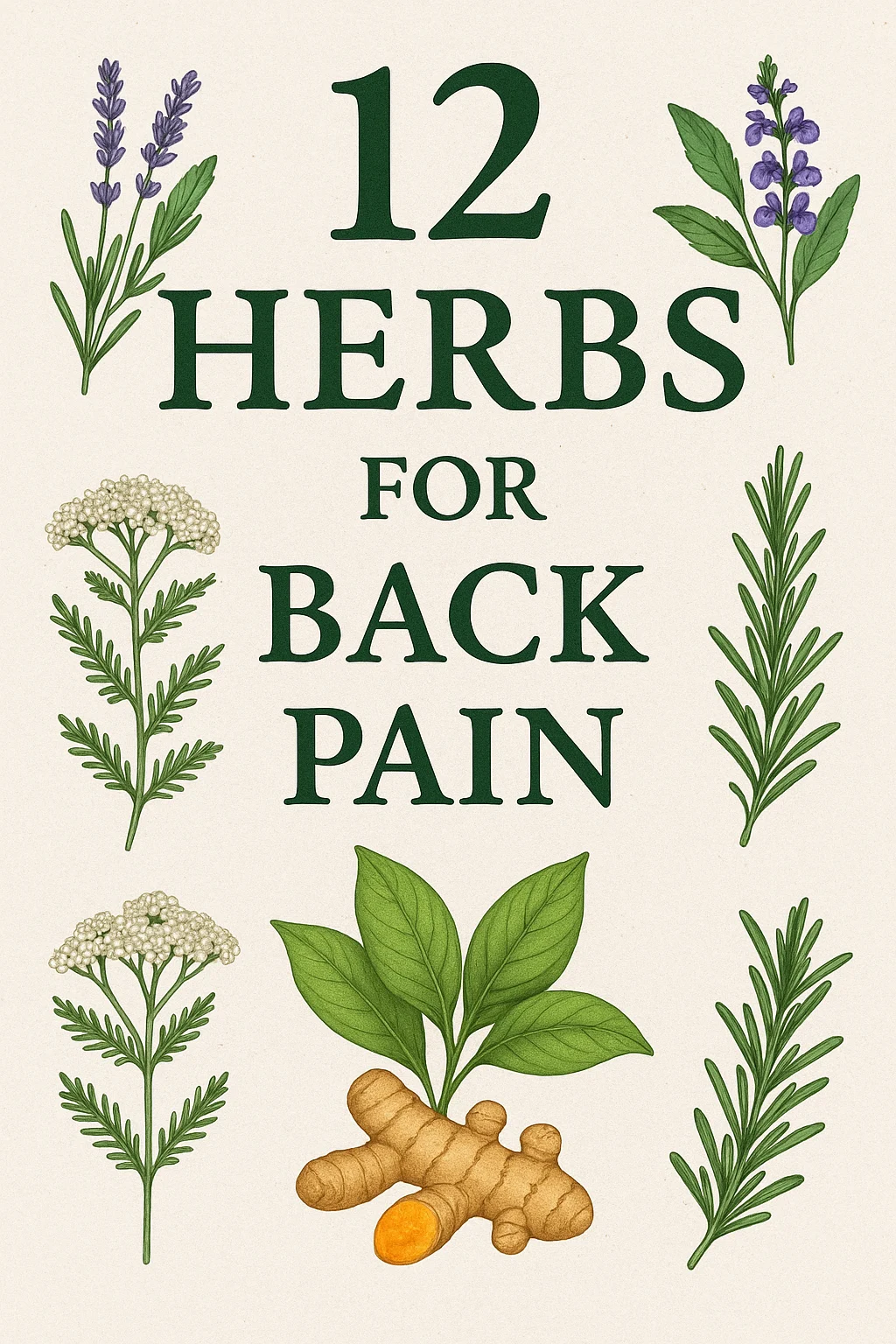Why You Deserve Real Relief from Back Pain—Naturally
Back pain isn’t just an inconvenience. It can disrupt your sleep, limit your mobility, affect your mood, and make even the simplest tasks feel impossible. You may have tried pills, creams, heating pads, and still not found lasting relief. The truth is, many conventional painkillers come with side effects, short-lived results, or the risk of dependency.

That’s why more people like you are seeking out herbs for back pain—natural, plant-based alternatives that work with your body to reduce inflammation, relax muscles, and support healing. Whether your discomfort is chronic, acute, or stress-related, the herbs you’ll learn about here offer time-tested solutions that are easy to use and often available right at home.
How Herbs Help with Back Pain Relief

When it comes to treating back pain, the root causes matter. You may be dealing with inflammation, muscle tension, nerve sensitivity, or even poor circulation. The right herbs for back pain can target these issues gently and effectively, often without the side effects of over-the-counter drugs.
Common Causes of Back Pain:
-
Muscle strain or overuse
-
Inflammation (arthritis, disc issues)
-
Nerve pain (sciatica, pinched nerves)
-
Poor posture or sedentary lifestyle
-
Stress-induced muscle tightness
Why Use Herbs?
-
Anti-inflammatory properties reduce swelling and pressure
-
Muscle relaxants help ease tension and cramping
-
Nervines calm the nervous system
-
Topical herbs can increase circulation and decrease stiffness
Let’s dive into 12 of the most effective herbs for back pain—and how you can use them to feel better naturally.
1. Turmeric (Curcuma longa)
Turmeric is one of the most popular herbs for back pain, thanks to its powerful anti-inflammatory properties.
-
How it works: The active compound curcumin reduces inflammation and blocks pain pathways
-
How to use: Take as a supplement, add to smoothies or teas, or mix into golden milk
-
Pro tip: Combine with black pepper to improve absorption
2. Ginger (Zingiber officinale)
Ginger warms the body, boosts circulation, and reduces pain similarly to NSAIDs—without the side effects.
-
How to use: Fresh ginger tea, grated in meals, or as a compress
-
Bonus: Ginger also aids digestion, which supports overall healing
3. Devil’s Claw (Harpagophytum procumbens)
Native to Africa, this herb is clinically shown to ease chronic back pain and improve mobility.
-
Best for: Lower back pain and inflammation
-
How to use: Capsules or tinctures, taken daily
-
Caution: Avoid if you have ulcers or take blood thinners
4. White Willow Bark (Salix alba)
Often called “nature’s aspirin,” white willow bark contains salicin—a compound that relieves pain and inflammation.
-
Use: Ideal for acute pain or flare-ups
-
How to take: As a tea, capsule, or tincture
-
Note: Not recommended for children or those allergic to aspirin
5. Boswellia (Boswellia serrata)
Also known as Indian frankincense, boswellia is excellent for inflammatory pain, especially in the spine and joints.
-
How to use: Capsules or concentrated extract
-
Why it works: It blocks 5-LOX, an enzyme that triggers inflammation
6. Arnica (Arnica montana)
One of the best topical herbs for back pain, arnica is used to treat bruises, soreness, and inflammation.
-
How to apply: Use as a salve, gel, or infused oil
-
Warning: Not for internal use—apply only to unbroken skin
If you’re passionate about natural wellness, there’s more to discover beyond herbs.
Medicinal Garden Kit offers a treasure trove of ancient remedies, forgotten healing foods, and survival nutrition secrets—many of which complement herbal pain relief.
7. Chamomile (Matricaria chamomilla)
Chamomile isn’t just for tea. It’s a gentle muscle relaxant and anti-inflammatory that calms both body and mind.
-
Best for: Stress-related tension and cramping
-
How to use: Drink as tea or use as infused massage oil
-
Extra benefit: Supports restful sleep, essential for pain recovery
8. Cayenne Pepper (Capsicum spp.)
Cayenne’s active ingredient, capsaicin, reduces pain by blocking neurotransmitters like substance P.
-
Use: Great for nerve-related or shooting pain
-
How to apply: Make a salve or use a store-bought capsaicin cream
-
Pro tip: Wear gloves when handling cayenne-based products
9. Lavender (Lavandula angustifolia)
Lavender oil is a go-to for soothing anxiety and easing physical pain. It improves sleep and reduces inflammation.
-
How to use: Massage into lower back, use in a diffuser, or apply with a warm compress
-
Combine with: Chamomile or arnica for a calming, anti-pain blend
10. Valerian Root (Valeriana officinalis)
Valerian is a nervine that targets pain caused by muscle spasms and stress.
-
How to use: Tea, tincture, or capsule
-
Best taken: Before bed to improve sleep quality and reduce pain flare-ups
11. St. John’s Wort (Hypericum perforatum)
Well-known for its mood-enhancing effects, St. John’s Wort is also excellent for nerve pain and sciatica.
-
How to use: Infused oil topically or tea
-
Caution: May interact with medications—use under guidance
12. Peppermint (Mentha piperita)
Peppermint oil contains menthol, which cools and soothes sore muscles.
-
How to use: Apply diluted essential oil to affected areas
-
Also great as: A compress or addition to bath water
📊 DIY Back Pain Relief Tea Blend (Table)
| Ingredient | Amount | Purpose |
|---|---|---|
| Dried turmeric | 1 tsp | Anti-inflammatory |
| Fresh ginger | 1-inch root | Pain relief, digestion |
| Chamomile flowers | 1 tbsp | Muscle relaxant, calming |
| Black pepper | Pinch | Enhances turmeric absorption |
| Honey (optional) | 1 tsp | Flavor and additional soothing |
Instructions: Simmer all herbs in water for 10–15 minutes. Strain and sip 1–2 times daily.
How to Safely Use Herbs for Back Pain
Using herbs for back pain is generally safe, but like any remedy, it requires awareness.
Tips for Safe Use:
-
Start with low doses and observe your body’s response
-
Don’t combine too many herbs at once
-
Avoid using during pregnancy unless approved by a healthcare provider
-
Always dilute essential oils before applying to skin
-
Research herb-drug interactions (especially St. John’s Wort, valerian, and devil’s claw)
📣 Want to Go Deeper Into Traditional Healing?
If you’re looking to expand your knowledge of natural pain relief,Medicinal Garden Kit is a powerful resource.Learn the ancient food-based remedies that supported wellness for centuries—many of which pair perfectly with the herbs you’ve just learned about.
✅ FAQ – Herbs for Back Pain
What are the best herbs for chronic back pain?
Turmeric, devil’s claw, and boswellia are often most effective for long-term inflammation.
Can I combine multiple herbs in one treatment?
Yes! Many herbs work synergistically. Try tea blends or topical oils using 2–3 compatible herbs.
Are herbal remedies as fast as over-the-counter painkillers?
They may act more slowly but provide more sustainable, side-effect-free relief.
What’s the best herb for nerve pain?
St. John’s Wort and cayenne are excellent for nerve-related back pain.
Are essential oils safe to use for back pain?
Absolutely—just remember to dilute them with a carrier oil to avoid skin irritation.
Conclusion – Choose Natural Support for a Stronger Back
Living with back pain doesn’t have to mean reaching for pills every day. Nature has equipped you with powerful, effective, and gentle tools to support healing. From turmeric and ginger to valerian and lavender, these 12 herbs for back pain can be your first line of defense.
Take a few small steps. Brew a tea. Make a salve. Add a few drops of essential oil to your evening routine. By integrating these remedies into your lifestyle, you’re not just treating pain—you’re restoring balance and honoring your body’s natural rhythm.
🛒 Recommended Resource
For readers serious about going beyond temporary fixes,Medicinal Garden Kit is a must-have guide.It reveals how our ancestors treated inflammation, pain, and chronic conditions using simple, powerful ingredients found in nature.

